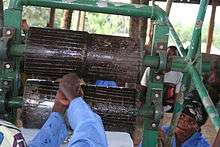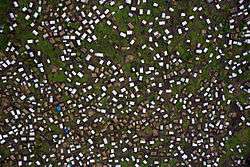Rutshuru Territory
| Rutshuru Territory | |
|---|---|
|
Partial view of the town of Kitchanga | |
 Rutshuru Territory | |
| Coordinates: 1°11′14″S 29°26′46″E / 1.187265°S 29.446004°ECoordinates: 1°11′14″S 29°26′46″E / 1.187265°S 29.446004°E | |
| Country | Democratic Republic of Congo |
| Province | North Kivu |
Rutshuru Territory is a territory in the North Kivu province of the eastern Democratic Republic of the Congo (DRC), with headquarters is the town of Rutshuru.
The territory is mountainous, including a large portion of the Virunga National Park, famous for its mountain gorillas. The people of the territory are extremely poor. Since 1992 they have suffered from ongoing violent conflict between different rebel groups and government troops. At its peak in November 2008 an estimated 250,000 people were made homeless. The violence has caused health issues, including the need for treatment after rape, which is common. Children have stayed away from those schools that are open for fear of being kidnapped by armed groups and made to fight.
Location
The territory lies in the Albertine Rift between Lakes Edward and Kivu. The Rutshuru River runs north through the territory, emptying into Lake Edward It is bounded on the north by Luberi Territory and Lake Edward. The eastern boundary is the international border with Uganda, and further south with Rwanda. To the south is the Nyiragongo Territory, beyond which is the provincial capital of Goma. To the east is Masisi Territory and Walikale Territory. The strategically important town of Kanyabayonga is just north of the territory on the road from Goma to Butembo. The territory includes a large part of the Virunga Mountains and Virunga National Park, which includes Mount Mikeno, an extinct volcano that rises to 14,557 feet (4,437 m).[1] The territory includes Bwito Chiefdom in the mountainous western section and Bwisha Chiefdom in the lower-lying eastern section.[2]
Climate
The territory is mountainous, with significant variations in climate from one part to another. Some parts are forested, others are mostly savanna with occasional trees. The soil in the south is generally rich and fertile. The climate is temperate and wet in the mountains, with temperatures between 3 °C (37 °F) and 18 °C (64 °F). Average annual rainfall in the south is about 1,800 millimetres (71 in), with two rainy seasons. Further north it is drier, warmer and less fertile.[3]
Economy

A study of the Bwito district of Rutshuru Territory found that almost all the people lived by agriculture, with most households owning or renting between a half hectare and five hectares of land. Other economic activities include small-scale trading, brewing of banana beer and logging. Before the conflicts that started in 1992, most households raised livestock and measured their wealth in terms of heads of cattle. However, almost all the herds were wiped out during the fighting. The population is extremely poor, and due to the continued insecurity their farming methods minimize risk rather than maximizing profit. Many of the households are headed by a widow.[3]
There have been incidents where elephants from the Virunga National Park have invaded farmlands in the territory, often causing considerable damage. Villagers typically retaliate by killing the animals, or getting soldiers to do the job. The tusks immediately disappear and the elephant is cut up for its meat.[4]
As internally displaced people return, land conflicts have grown to alarming levels. Conflicts, often between ethnic groups, have always existed. A number of factors have made the problem worse. At a basic level, there is not enough land to go around. Also, influential people have obtained large landholdings during the period of conflict, and some of these are members of the military or the government. Many people rely on customary law for their land titles, while the government only recognizes formal land certificates. Some of the better-informed have obtained such certificates, displacing the former users of the land.[5]
Security problems

Conflict has afflicted Rutshuru territory since inter-ethnic fighting broke out in 1992-1993. The Rwandan Civil War (1990-1993) followed by the Rwandan Genocide of 1994 caused many Hutu refugees to enter the region, while the Congolese Tutsi population left for Rwanda. This led to the First Congo War (1996-1997), followed by the Second Congo War (1998-2003). In these wars Rwanda took an active role in supporting rebels opposed to the government, including supplying troops. Rwanda accused the DRC government of supporting the Interahamwe militia, Hutus who had been involved in the genocide. An interlude of peace began in 2002.[3]
In 2005 violence flared up again when Laurent Nkunda, an officer in the RCD-Goma rebel group, rejected the authority of the government and retreated with some of the RCD-Goma troops to the Masisi forests to the west. This was the start of the long-running Kivu conflict.[6] A warrant for Nkunda's arrest on charges of war crimes was issued in September 2005. In January 2006 his forces attacked and occupied several towns in Rutshuru Territory including Tongo, Bunagana and Rutshuru. The troops looted the towns and raped or killed civilians who were unable to escape.[7]
In October and November 2008 there was severe conflict in the region between government troops and rebels led by Laurent Nkunda, with an estimated 250,000 people made homeless.[8] Nkunda claimed his CNDP forces were protecting his Tutsi community from attacks by Hutu rebels of the FDLR who fled to the DRC after the Rwandan Genocide.[9] Throughout 2010 there were repeated security incidents. As of September 2010, camps dotted throughout Rutshuru territory held 77,000 internally displaced people.[1]
On 2 June 2011 the United Nations Stabilization Mission in the Democratic Republic of Congo (MONUSCO) launched Operation "Restore Hope" in Rutshuru territory, a concerted drive to suppress violence through 24-hour patrols.[10]
As of November 2012, the Congolese government no longer controls the town of Rutshuru. It is a stronghold of the rebel, or self-styled 'revolutionary' M23 Movement.[11]
Health and education

Members of the armed groups involved in the conflict frequently rape women and girls as a means of intimidation. In addition to physical and emotional trauma, the women are at risk of unwanted pregnancies, miscarriages and sexually transmitted diseases including HIV/AIDS. Many of the health risks can be reduced if medical treatment is available within 72 hours of an attack. USAID has funded a number of health centers in the region, providing treatment for various common health problems so that rape victims can obtain local treatment anonymously and at no cost.
Many schools in the region have been closed due to the insecurity. School children avoid going to school for fear of being attacked and forcibly recruited into one of the armed groups. Thirty-seven children were recruited in Rutshuru in October 2008. Boys have to fight while girls become "wives" for the soldiers. Some children have been released and then recruited again more than once.[12] By November 2008, 85% of the 310 schools in Rutshuru territory were closed. An estimated 150,000 children were out of school.[13]
References
- 1 2 "Province du Nord Kivu: Situation de retournés (Janvier 2009 à Septembre 2010)" (PDF). Bureau de la Coordination des Affaires Humanitaires des Nations Unies - République Démocratique du Congo. 8 October 2010. Retrieved 2011-10-29.
- ↑ X. Blaes (October 2008). "Découpage administratif de la République Démocratique du Congo" (PDF). PNUD-SIG. Retrieved 2011-11-02.
- 1 2 3 Yuvé Guluma (January 2003). "HOUSEHOLD ECONOMY ANALYSIS OF THE RURAL POPULATION OF SOUTH-WESTERN BWITO, RUTSHURU, NORTH KIVU, DEMOCRATIC REPUBLIC OF CONGO" (PDF). Save the Children. Retrieved 2011-10-29.
- ↑ "Elephants wreak havoc in Rutshuru". IRIN. 22 Jun 2005. Retrieved 2011-10-29.
- ↑ Oumar Sylla (November 2010). "Land and property disputes impeding return and reintegration". Forced Migration Review. Retrieved 2011-10-29.
- ↑ "D.R. Congo: Arrest Laurent Nkunda For War Crimes". Human Rights Watch News. 2006-02-01. Retrieved 2011-10-29.
- ↑ "HRW urges arrest of RCD-Goma war crimes suspect Laurent Nkunda". January 31, 2006. Retrieved 2011-10-29.
- ↑ "AIDING SURVIVORS OF GENDER-BASED VIOLENCE IN THE DEMOCRATIC REPUBLIC OF THE CONGO (DRC)" (PDF). USAID. April 2010. Retrieved 2011-10-29.
- ↑ "Head rebel 'backs DR Congo peace'". BBC News. 16 November 2008. Retrieved 2011-10-29.
- ↑ "Peace and Security Restored in the Territory of Rutshuru". MONUSCO. 17 Jun 2011. Retrieved 2011-10-29.
- ↑ Gettleman, Jeffrey (2012-11-25). "As Rebels Gain, Congo Again Slips Into Chaos". The New York Times.
- ↑ "DRC: Recruitment of child soldiers rising". IRIN. November 11, 2008. Retrieved 2011-10-29.
- ↑ "DRC: 150,000 children miss school as violence continues in the east". IRIN. November 15, 2008. Retrieved 2011-10-29.
